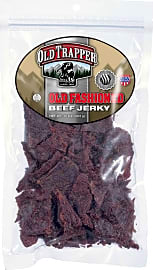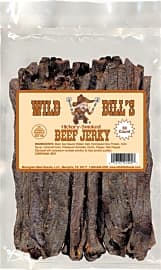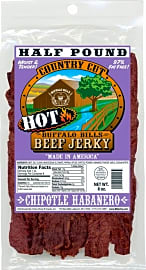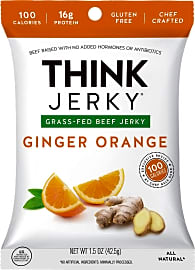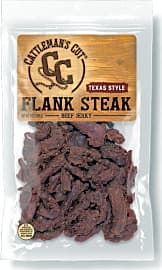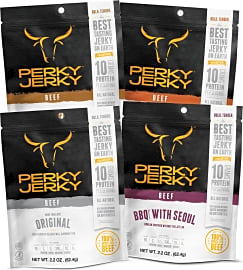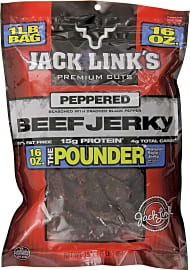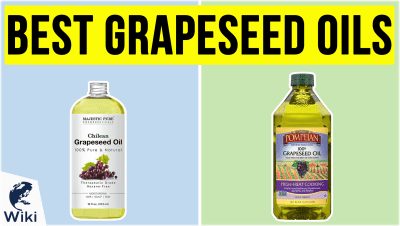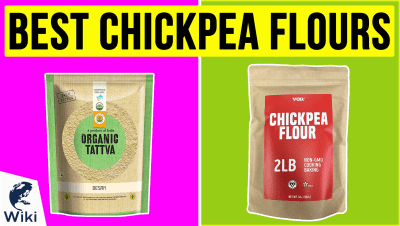The 10 Best Beef Jerkies

This wiki has been updated 37 times since it was first published in July of 2015. You may not need them to take on a cattle drive or a long wilderness hunting expedition these days, but for a quick and convenient snack that's protein packed, tasty, lightweight and perfect for hiking, you can't beat beef jerky. They come in a huge range of flavors, and our selections include everything from semi-sweet teriyaki to spicy hot, and both juicy and dry varieties. When users buy our independently chosen editorial selections, we may earn commissions to help fund the Wiki.
Editor's Notes
August 07, 2020:
Whether you are looking for a low-carb snack to help keep you full throughout the day or something that is easy to toss in a backpack on long hike, beef jerky fits the bill. We mostly focused on finding varieties that were made without a bunch of chemicals and difficult to pronounce ingredients. That being said, we did still include some classics, specifically Jack Link's Peppered because we know how much people enjoy it, even if it does contain MSG.
If you want something as pure as possible, People's Choice Old Fashioned, which contains just beef, water, and seasoning, is a smart choice. Wild Bill's Hickory Smoked Strips is another good option that is made with just beef, soy sauce, and natural flavors, as is the Naked Cow Sampler, which only contains ingredients that will be instantly recognizable for people without food science degrees, such as black pepper, garlic powder, and sea salt.
If you are sensitive to MSG, you'll want to avoid Buffalo Bill's Chipotle Habanero Country Cut, along with the aforementioned Jack Link's Peppered. Both of these also contain sodium nitrates, as does Cattleman's Cut Texas Style. However, their bold taste make them a worthwhile option for anyone who isn't bothered by those additives.
Those who like to eat different flavors every day should consider the Perky Jerky Variety Pack and Naked Cow Sampler. The former comes with four interesting varieties, including Hot & Bothered" and "BBQ with Seoul" while the latter comes with classics like smoke and honey. Think Jerky is also available in a variety pack of appetizing flavors like honey teriyaki and sweet chipotle, and it has a very limited ingredient list that most people with food sensitivities can handle.
February 26, 2019:
For anyone looking to cut down on carbs, every beef jerky is a sensible snack, but those truly health-conscious individuals looking to cut out as much unnatural foods as possible will want to consider People's Choice Old Fashioned, Old Trapper Original, and Naked Cow All Natural Sampler, since these only contain all-natural ingredients. People's Choice Old Fashioned and Naked Cow All Natural Sampler are also sugar free. If you like your jerky thick and juicy, rather than dry and chewy, then take a look at Buffalo Bill's Chipotle Habanero Country Cut, Chops Beef Teriyaki, and Jack Link's Peppered. Those who aren't sure of exactly which flavor they will like best, or who just enjoy having a variety of options on hand, should consider the Bayou Blend Tester Pack, Perky Jerky Variety Pack, or Naked Cow All Natural Sampler.
Special Honors
Patagonia Provisions Original Buffalo Jerky While Patagonia Provisions Original Buffalo Jerky may not be beef, most will find it satisfies the same craving, and some may even find the taste better. It is made almost exclusively with organic ingredients, and as an added bonus, it is lower in calories and fat, yet higher in protein than beef. patagoniaprovisions.com
Preserving With Precision, Patience, and Persistence
The curing solution penetrates the beef over an extended period of time, while the salt and seasoning help prevent the growth of bacteria.
Many of us understand the grab-and-go mentality of snacking. You just want something quick, easy to consume, and full of flavor to satisfy your craving. When hunger strikes between meals, ditch the excess fat of a fast food burger or the sugar of a candy bar in favor of a more healthy alternative, like a package of beef jerky.
Beef jerky is defined as a lean strip of meat trimmed of its fat, cured, and dried for prolonged preservation and storage. Its preparation is broken down into a five-stage process. The first stage involves the treatment of whole-muscle beef by removing its bones, connective tissues, and fat. Fat removal is accomplished using one of three possible methods: centrifugal force, whereby the spinning motion of a large container separates liquid fat particles from the flesh; pressing the meat, which squeezes the liquid fat out; and filtering. Once fat has been removed, the remaining chunks of beef are placed onto conveyor belts and mesh screens for inspection. From here, the beef is shaken to remove any undesirable contaminants before additional processing takes place.
The second stage involves mixing and heating the intended curing solution. This occurs inside a large metal tank equipped with mixing blades that incorporate water, salt, and other seasonings.
Third comes the processing and curing of the beef itself. During this stage, the beef is frozen and partially thawed, allowing it to release some of its natural juices. An automatic cutting machine is then used to chop the beef into even smaller chunks before they are dipped into the heated curing solution. The curing solution penetrates the beef over an extended period of time, while the salt and seasoning help prevent the growth of bacteria.
During the fourth stage, the beef is molded into blocks and re-frozen to a temperature between 18 and 28 degrees Fahrenheit. Once frozen, the beef is cut into thin, fibrous strips and placed onto wire mesh trays for drying and cooking in ovens. The drying and cooking process reduces the beef's overall moisture by up to 40 percent over a period of 12 hours. Once the beef is appropriately cured and dried, it must then be stored and packaged in a manner that minimizes excess oxygen exposure. Doing so ensures an extended shelf life for the final jerky product so that it doesn't spoil by the time it is purchased at a gas station or convenience store.
Beef jerky packaging is prepared in one of three ways: a nitrogen flush, use of food-grade oxygen absorbers, or vacuum sealing to keep the contents fresh.
Keep in mind that some beef jerkies are also smoked at low heat levels, which not only adds to the antibacterial properties of the salt, but also infuses the snacks with plenty of flavor. Many beef jerkies available on the market today are also marinated in vinegar or citrus juices to create flavors similar to those produced by the smoking process.
Consider Your Cravings Practically
Beef jerky is typically low in fat and rich in essential amino acids, making it an excellent source of protein for the body. This is particularly useful if you're an athlete or bodybuilder who requires muscle recovery following an intense workout. Being that beef jerky doesn't require any refrigeration, it's a much more convenient snack to eat on the road, as no additional power is needed to keep it fresh or chilled.
Being that beef jerky doesn't require any refrigeration, it's a much more convenient snack to eat on the road, as no additional power is needed to keep it fresh or chilled.
While flavor, seasoning, and texture are all important considerations, the type of packaging used for jerky storage is equally important. Vacuum-sealed packaging, oxygen absorbers, or even a combination of the two help maintain your jerky's freshness during periods of extended travel. Look for packages that are resealable, so you don't have to worry about finding another airtight container in which to place your snack once its original packaging has been opened.
If possible, you should consider a jerky brand with minimal levels of MSG and nitrates. Given the requirements of jerky preservation, you may not be able to eliminate these additives from your search entirely, but it's important to be aware of their presence and the amounts contained within jerky products.
A Brief History Of Beef Jerky
Dehydration and preservation of meat has a long history dating back to ancient Egyptian times when food was left out to dry in the natural heat of the sun.
The popularity for snacking on the go has grown considerably over the last 200 years.
Beef jerky first appeared in the 1800s, thanks to the South American Quechua tribe. Considered direct descendants of the ancient Inca, the Quechua produced a meat very similar to modern day jerky, which they called ch'arki or charqui. Charqui was made by adding salt to strips of meat from a variety of game animals, including deer, buffalo, and elk. It would then be left out to dry in the sun or placed over a fire to cook for extended periods of time. This allowed people to preserve food during seasons when it was plentiful so they could survive seasons when the food supply was scarce.
Many Native American cultures combined mixed berries, fat, and ground meat to make small cakes known as pemmican. The first American settlers used pemmican as a model for jerky preservation. Cowboys of the 1820s were also known to carry jerky with them on cattle drives.
The popularity for snacking on the go has grown considerably over the last 200 years. That, combined with a modern desire for high-protein foods, has lead to the presence of various flavors and textures for beef jerky that suit all tastes and circumstances. Today's beef jerky is ideal for both indoor and outdoor enjoyment alike, thanks to the fact that it doesn't melt, it doesn't require refrigeration, and because it's easy to carry around.


